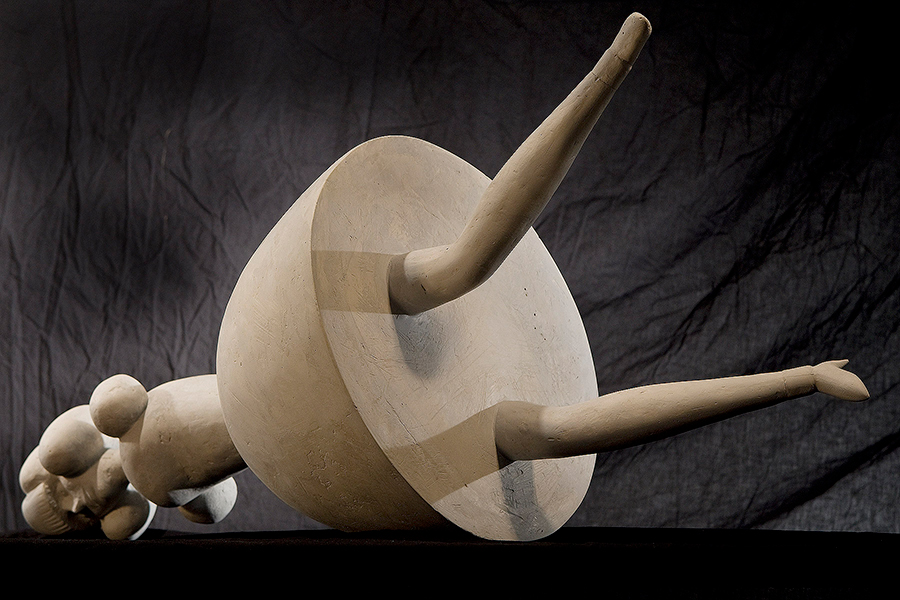Each summer, MAG presents a showcases of regional art—in alternate years, the juried Rochester-Finger Lakes Exhibition or
the invitational Rochester Biennial. For this year’s Biennial, the Gallery’s director and curators have selected A. E. Ted Aub of Geneva (sculpture), Anne Havens of Rochester (multiple media), Rick Hock of Rochester (digital imaging), Alberto Rey of Fredonia (painting and video), Julianna Furlong Williams of Spencerport (painting), and Lawrence M. “Judd” Williams of Spencerport (sculpture). As in previous years, one artist (Havens) was selected on the strength of her work in last year’s Rochester-Finger Lakes Exhibition.
“We aimed for variety, but insisted on quality,” says director of exhibitions Marie Via. “The thread that connects all six is commitment to excellence.”
About the Artists
A. E. Ted Aub
The work of Ted Aub shares affinities with the elegant sculptures of Elie Nadelman and the surreal paintings of René Magritte. Folk art has also been a strong influence, as have popular 19th-century illustrations known as “upside-downs,” in which turning an image on its head produces a completely different picture. “In part,” says Aub, “it is my intention to blur the distinction between that which is horrific and humorous, and, in the tradition of the absurd, to find meaning in the meaningless.”
In addition to teaching sculpture at Hobart and William Smith Colleges for three decades, Aub has been awarded numerous public commissions in the US and Korea. At MAG, he has exhibited in six Rochester-Finger Lakes Exhibitions and been a prize winner in three.
Anne Havens
“Art-making is my way of dealing with life,” writes Anne Havens. “It lets me act out, exorcise, focus, resist disintegration and, most of all, be surprised.”
A “mostly self-taught artist with some formal study at Stanford University, Academie Julian, Rochester Institute of Technology, and the Memorial Art Gallery,” Havens expresses herself equally comfortably through sculpture, printmaking, drawing, ceramics, photography, video and artist books. Her work for the Biennial uses recurring motifs of knives, forks and spoons to symbolize the creative process.
In keeping with recent tradition, Havens was chosen on the strength of her entry in last summer’s Rochester-Finger Lakes Exhibition.
Rick Hock
Inspired by the work of Henri Cartier-Bresson and Robert Frank, Rick Hock left the publishing field and went back to school to learn photography. After receiving a master’s degree in photographic studies at Rochester’s Visual Studies Workshop, he worked for 30 years at the George Eastman House, where he was able to study firsthand the work of world-renowned photographers.
In his own work, he soon abandoned traditional photography and began manipulating images. “By juxtaposing images of seemingly unrelated subjects,” says Hock, “I can invent new possibilities for meaning.”
Hock’s voracious reading habits, on subjects ranging from nanotechnology and mummies to the Cold War and Chicago blues, are reflected in the diverse themes explored in his work.
Alberto Rey
“I began to conceptualize this series about ten years ago,” says Alberto Rey of his portraits of dead steelhead. By the time he started the eight- to ten-foot paintings, he had spent countless hours researching his subject. “I began to see these bodies as metaphors for my own life.” An avid outdoorsman and professional fishing guide, he also references the artistic traditions of trophy painting and finding beauty in ruins and decay.
Born in Havana, Cuba, Rey came to the United States as a child. After receiving an MFA from SUNY Buffalo and doing post-graduate work at Harvard, he became a professor of art at SUNY Fredonia, where he has taught for 21 years.
Julianna Furlong Williams
“I started this series based on a ledger from 1918 that had belonged to my great-uncle,” says Julianna Furlong Williams. The concept of germs was still relatively new at that time as an influenza pandemic killed 50 to 100 million people, most of them healthy young adults. Splashes of red suggest the fever and violent coughing fits suffered by the infected; rabbits symbolize a generalized victimhood. Williams’s paintings evoke the reality of death carried by such invisible agents as cancer, AIDS and biological weapons.
A graduate of RIT and Tufts University, Williams has taught painting and drawing at SUNY Brockport and Monroe Community College. Since her retirement, she spends most of her time creating layered paintings that are repositories of both public and private history.
Lawrence M. “Judd” Williams
After earning degrees at the Kansas Art Institute and the University of Illinois, Judd Williams devoted himself to students at the Rochester Institute of Technology, where he taught painting, printmaking, sculpture and figure drawing from 1963 until his retirement in 2000.
Williams, who humbly describes himself as a “rough carpenter influenced by Gorky and Picasso,” scavenges wood strips from buildings about to be demolished and pieces them together as textured geometric studies. He stencils and paints them, scratches them, burns in marks with a blow torch, and attaches found objects to create wall pieces that exhibit a formal beauty.
During the Biennial, a selection of Williams’s sculpture and drawings from the Gallery’s collection will be on view near the museum entrance.
This exhibition is sponsored by the Elaine P. and Richard U. Wilson Foundation, with additional support from ESL Federal Credit Union, Edward and Marilynn McDonald, and the Rubens Family Foundation.

